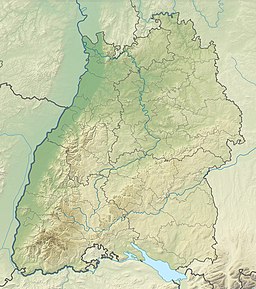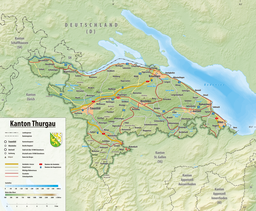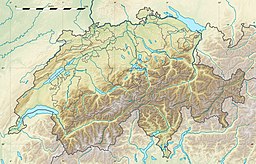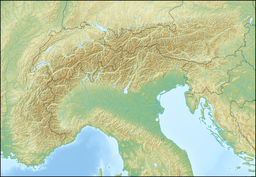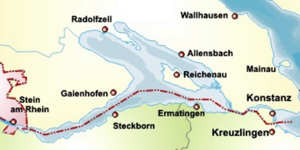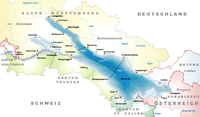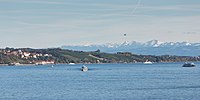
The Rhine is one of the major European rivers. The river begins in the Swiss canton of Graubünden in the southeastern Swiss Alps. It forms part of the Swiss-Liechtenstein, Swiss-Austrian, and Swiss-German borders. After that the Rhine defines much of the Franco-German border, after which it flows in a mostly northerly direction through the German Rhineland. Finally in Germany, the Rhine turns into a predominantly westerly direction and flows into the Netherlands where it eventually empties into the North Sea. It drains an area of 9,973 km2 and its name derives from the Celtic Rēnos. There are also two German states named after the river, North Rhine-Westphalia and Rhineland-Palatinate.

Lake Constance refers to three bodies of water on the Rhine at the northern foot of the Alps: Upper Lake Constance (Obersee), Lower Lake Constance (Untersee), and a connecting stretch of the Rhine, called the Lake Rhine (Seerhein). These waterbodies lie within the Lake Constance Basin in the Alpine Foreland through which the Rhine flows. The nearby Mindelsee is not considered part of Lake Constance.
Konstanz is a Landkreis (district) in the south of Baden-Württemberg on the German-Swiss border, situated along the shores of Lake Constance. Neighboring districts are Schwarzwald-Baar, Tuttlingen, Sigmaringen and Bodenseekreis. To the south it borders the Swiss cantons of Zurich, Thurgau and Schaffhausen. The municipality of Büsingen am Hochrhein is an exclave of Germany surrounded by Swiss territory.

The Gnadensee is part of Lower Lake Constance, the western part of the lake.
Aach is a German-language toponym and frequent element in place names and may refer to:

Bodanrück is the 112 km2 (43 sq mi) wide peninsula that divides Lake Constance into Überlinger See and Gnadensee, which is part of Untersee. At its southern end, it reaches the Seerhein, which links Obersee with Untersee.

The Seerhein is a river about four kilometres long, in the basin of Lake Constance. It is the outflow of the Upper Lake Constance and the main tributary of the Lower Lake Constance. The water level of the lower lake is about 30 cm below the level of the Upper Lake. It is considered part of the Rhine, which flows into Lake Constance as the Alpine Rhine and flows out of the Lake as the High Rhine. The Seerhein arose after the last ice age. Some time after this period, the water level of Lake Constance gradually dropped by about ten metres and the shallow parts fell dry. Some parts of the Seerhein still have a character a bit like a lake.

The Obersee, also known as Upper Lake Constance, is the much larger of the two parts of Lake Constance, the other part being the Untersee.

Lake Überlingen is the northwestern "finger" of the Obersee, the lower part of Lake Constance. The boundary of lake is defined as the ferry link from Meersburg to Constance. It extends north to Bodman-Ludwigshafen.

The Radolfzeller Aach is a right or north tributary of the Rhine in the south of Baden-Württemberg (Germany). It is approximately 32 km long.

Werd Island is the main island of the small island group Werd Islands in the westernmost part of the Lower Lake of Lake Constance just before the High Rhine leaves the part of the lake known as the Rhine Lake. It is located on Swiss territory between Stein am Rhein and Eschenz.

Triboldingerbohl, also known as Triboltingen or großes Bohl or Langenrain, is the fourth largest island of Lake Constance, with an area of 0.13557 square kilometres (0.05234 sq mi). It is 780 meters (2,560 ft) long and up to 230 meters (750 ft) wide. It is located in the easternmost part of the Untersee, near the point where the Seerhein flows into the lake. This part of the lake is also known as the Rheinsee. It belongs to the Wollmatinger Ried nature conservation area; administratively it belongs to the district industrial area of the City of Constance. Until 1934, it belonged to the municipality of Wollmatingen, which was then annexed by Constance. Triboldingerbohl lies 2.1 km (1.3 mi) southeast of Reichenau Island and 1.6 km (0.99 mi) from the dam that connects Reichenau to the mainland. The area between Triboldingerbohl island and the Reichenau dam is called Ermatinger pool and is an ecologically important shallow-water zone.
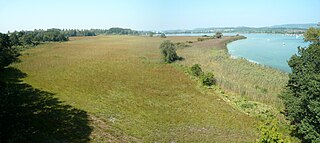
Mettnau is a peninsula, located east of the town of Radolfzell in the western part of Lake Constance. It lies between the Markelfingen corner in the north and the Zeller See in the south and has a length of 3.5 kilometers and a width of up to 800 meters, a size of 140 hectares.

The Dominican Island or Constance Island is an island in Lake Constance immediately east of the city of Constance. With an area of 1.8 hectares, it is one of the smaller islands in the lake. The island is separated from the city center by a six-metre-wide (20 ft) channel, and connected to it by a bridge. The island is dominated by the Steigenberger hotel, which is housed in the former Dominican convent.

The border between the modern states of Germany and Switzerland extends to 362 kilometres (225 mi), mostly following Lake Constance and the High Rhine, with territories to the north mostly belonging to Germany and territories to the south mainly to Switzerland. Exceptions are the Swiss canton of Schaffhausen, the Rafzerfeld of the canton of Zürich, Bettingen and Riehen municipalities and part of the city of Basel in the canton of Basel-City and the old town of the German city of Konstanz, which is located south of the Seerhein. The canton of Schaffhausen is located almost entirely on the northern side of the High Rhine, with the exception of the southern part of the municipality of Stein am Rhein. The German municipality of Büsingen am Hochrhein is an enclave surrounded by Swiss territory.
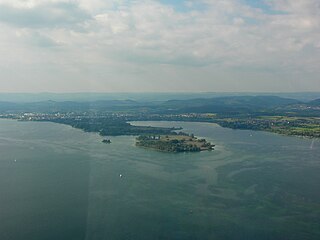
The Markelfinger Winkel is the part of Lake Constance between the upper part of the Mettnau Peninsula and Markelfingen. It is the northwestern continuation of the Gnadensee and its parent lake, the Untersee. It has an area of around one square kilometre.
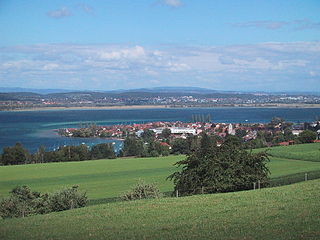
The Rhine leaves that part of Lake Constance known as the Upper Lake or Obersee as the Seerhein near Konstanz. After six kilometres it forms the Rheinsee, through which the river current flows. At its outflow is the island of Werd with its Franciscan monastery. The Rheinsee, together with the Zeller See and the Gnadensee, which surround the island of Reichenau, form the Untersee. The latter, together with the Seerhein, are considered part of Lake Constance.

The Zeller See is part of the Lower Lake, the lower part of Lake Constance. It lies in the bay of Radolfzell, and between the peninsula of Mettnau to the north and the peninsula of Höri to the south. To the west it is bounded by the ried of the Radolfzeller Aach.

The nature reserve of Wollmatinger Ried – Untersee – Gnadensee is a protected area on the shores of Lake Constance in Germany. It has an area of 767 hectares and is the largest and most important nature reserve on the German side of Lake Constance. It is rich in plant and animal species and extends from the banks of the Seerhein river west of Constance via the causeway to the Island of Reichenau in the Untersee to the eastern Gnadensee near Allensbach-Hegne. The nearby offshore islands of Triboldingerbohl (Langenrain) and Mittler or Langbohl (Kopf) are part of the reserve.
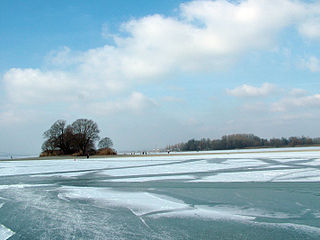
The Liebesinsel is a small, uninhabited island on Lake Constance in Germany.


